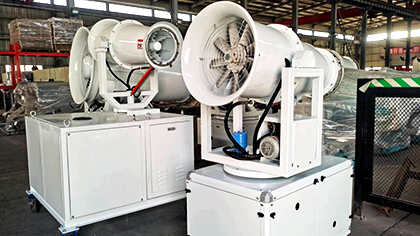Fog cannon machines utilize high air
pressure to pressurize water, which is
then propelled through high-pressure
nozzles via pipelines to produce a fine
water mist. This mist is sprayed into
the air, effectively absorbing fine dust
and airborne particles, thereby achieving
dust reduction.
ZhenTon's fog cannons are categorized into four main
types based on their primary applications: mobile fog
cannons, vehicle-mounted fog cannons, fixed fog
cannons, and high-tower fog cannons.Each type offers
distinct characteristics tailored to specific operational
needs.
1. Mobile Fog Cannon Features:
Easy mobility with strong wind speed, long range, and
wide coverage area.
Remote control operation from all directions (front,
back,left,right).
Options for constant,low volume,or ultra-low volume
spray.
Available in mobile or drag-type configurations with a
choice of three-phase 380V voltage.

2. Vehicle-Mounted Fog Cannon Features:
Long range with minimal water consumption.
Effective range adjustable from 20-120 meters.
Significant reduction in dust compared to traditional
self-spraying equipment.
360-degree rotation capability for enhanced
maneuverability and easy deployment at industrial and
mining sites.
3. Fixed Fog Cannon Features:
High wind speed and penetrating power.
Capable of fine mist particle spray with high efficiency and
wide coverage.
Remote control operation for precise elevation and
Versatile installation options on fixed platforms or
various vehicles.
4. High-Tower Fog Cannon Features:
Designed for installation on towers with extensive spraying
and large coverage area.
High operational efficiency and rapid deployment.
One-touch start with heating and heat preservation
features for stable operation.
Regardless of the type chosen,fog cannon machines
significantly enhance operational efficiency and reduce
overall equipment investment compared to traditional
self-spraying methods. They offer superior flexibility
and application power across various industrial and
environmental settings.










